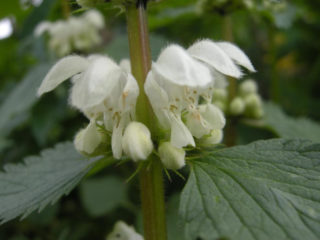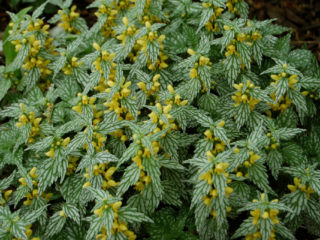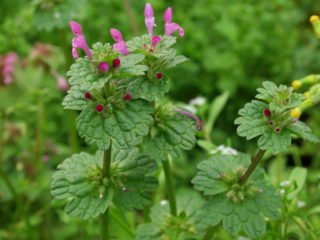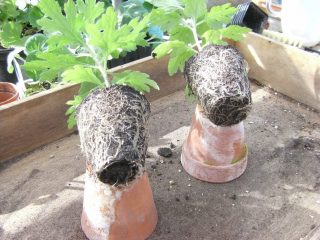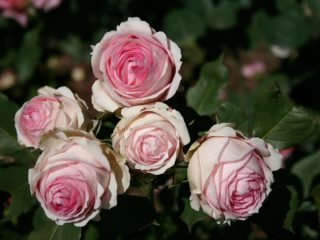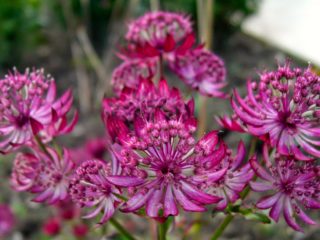Content
Purple nettle (Lamium purpureum), or red nettle, is a herbaceous medicinal plant native to Eastern Europe, which recently can be increasingly found in garden plots. Some gardeners consider the crop to be a weed, while others specifically grow it as an ornamental plant, since it remains spectacular and green throughout the spring and all summer. Also, purple damask is an excellent honey plant and has medicinal properties. In addition, the grass is completely unpretentious in care and cultivation and can grow on any land.
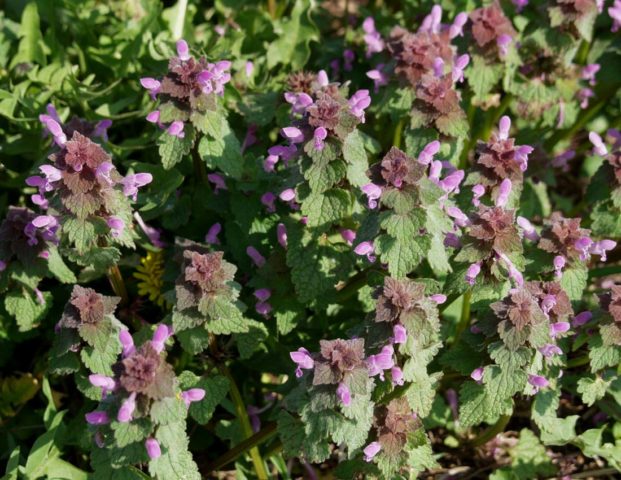
Externally, purple nettle resembles stinging nettle
Description and characteristics
Purple lily, a description and photo of which are presented below, is a biennial plant, but some of its species can also be annual. The height of the crop usually grows to 30 cm. The stems are erect or creeping, colored green, with a slight reddish tint. The leaves are wrinkled with many veins and covered with soft hairs. Those located on top of the plant have a beautiful purple color. The flowers are in the axils, sessile, and come in a variety of colors: pink, white, purple.The flowering period is long - from April to October.
The herb has found its use in folk medicine. Infusions and decoctions prepared on its basis are used to treat various diseases. In addition, housewives use the plant to prepare herbal cocktails, filling pies, vitamin salads, and it makes delicious green borscht.
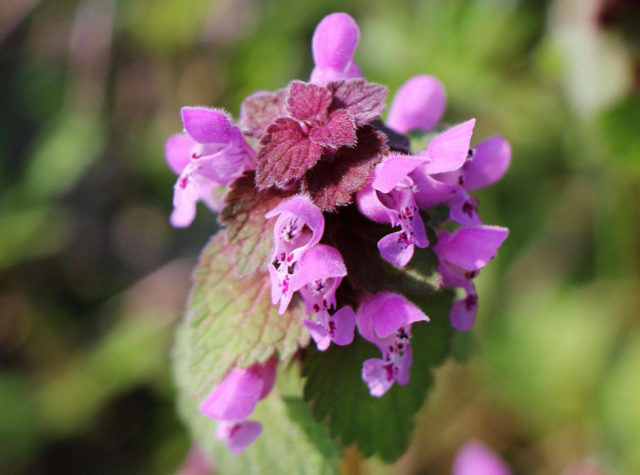
In its raw form, purple damselfish tastes like spinach.
Where does it grow
This herbaceous plant can be found in almost all corners of our country, with the exception of the cities of the Far Eastern region. Most often, purple claret grows on the outskirts of ravines, near ditches, among sparse bushes, on forest edges, in squares and parks. Prefers calcareous, aerated, loamy soils. Yasnotka is common in the Caucasus, Eastern and Western Siberia, and the European part of the country. It often infests vegetable and grain crops. Many people consider it a weed in the garden, where it is commonly found along hedges or under trees.
When planting purple claret, it is better to select areas located in partial shade. The soil should be loose and moist.
Medicinal properties of Clary purpurea
The herbaceous plant contains many useful substances:
- flavonoids;
- alkaloids;
- amino acids;
- organic acids;
- saponins;
- essential oils;
- lamiin;
- tannins;
- carotene.
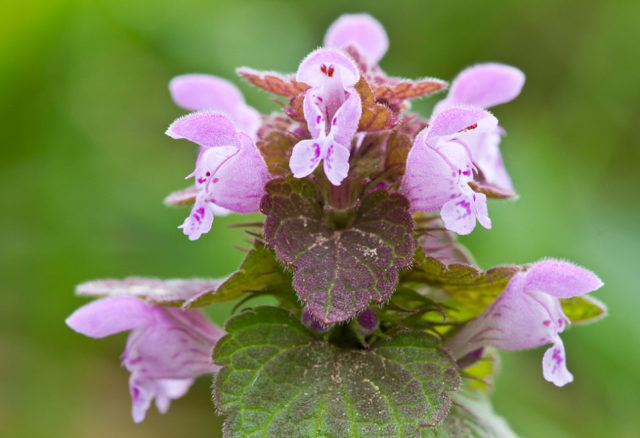
The leaves contain ascorbic, coumaric and caffeic acids
The leaves and flowers of purple jasmine are widely used in folk medicine. Decoctions, infusions and teas from it are used for diseases such as:
- hernias;
- cystitis;
- urethritis;
- haemorrhoids;
- tumors of various etiologies;
- scrofula.
It is worth noting that the beneficial properties of purpurea are subject to active research by specialists. Despite the fact that the plant is not included in the Russian pharmacopoeia, it has been scientifically proven that products based on it are used as a hypotensive, anti-inflammatory, hypnotic and hemostatic agent. Since jasmine contains tannins that have astringent properties, it helps in cleansing the skin of various types of rashes. The presence of flavonoids helps reduce blood pressure and strengthens capillary walls. The plant contains mucus and has an excellent expectorant effect. Purple clasp tea can relieve colds, helps with iron deficiency in the blood, and its regular use relieves women of gynecological problems and pain during menstruation. The use of the herb as a prophylactic for mild ailments, diseases of the digestive, circulatory and nervous systems is very effective.
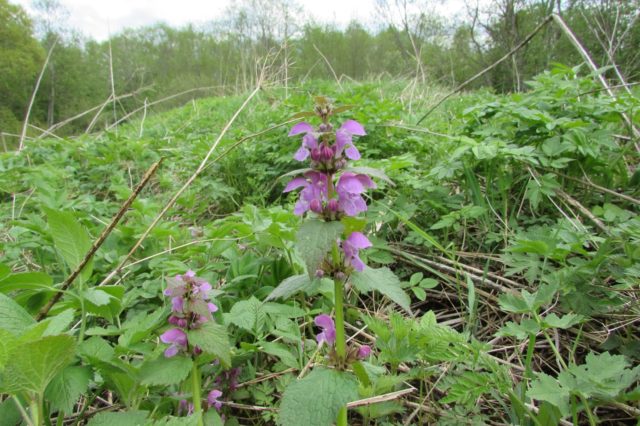
Purple lily has a positive effect on the functioning of the entire human body
Use in folk medicine and recipes
There are a large number of recipes that contain purple claret. It can be included in herbal preparations or used separately. Most often, tea is made from claret. In addition to its pleasant taste, it has a considerable list of medicinal properties. Many people advise taking it for respiratory diseases, skin problems, anemia and to increase appetite.Women drink this tea for leucorrhoea and pain during menstruation. For older people, it will be a good sedative and will help cope with insomnia.
It is not difficult to prepare a medicinal drink; for this you should:
- Pour 2 teaspoons of purpurea clasp into 200 ml of water.
- Bring the solution to a boil.
- Let sit for 5 minutes.
- Drink 2-3 cups daily.
In addition to tea, for medicinal purposes it is allowed to use an infusion of purpurea damselfish; it is prepared according to the following recipe:
- Pour 30-40 g of herb with one glass of boiling water.
- Leave to brew in a thermos for half an hour or in a glass container for 60 minutes.
- Strain through cheesecloth or strainer.
- Drink 2 tablespoons before meals.
The infusion should be stored in the refrigerator for no more than 24 hours.
For uterine bleeding, use the following recipe:
- Pour 10 g of jasmine flowers into 300 ml of high-quality vodka.
- Leave for 7 days in a warm and dark place (stir daily).
- Strain.
- Take 30 drops every day.
In addition to bioactive additives, fresh crushed purple clasp greens are used as compresses. Used to treat wounds, eczema, inflammation, and pustular lesions of the skin.
Contraindications
There are no harmful or toxic substances in the composition of purpurea, so products prepared on its basis can be drunk without fear, and you cannot be poisoned by them even in case of an overdose.However, it is recommended to use it with caution in categories of people with increased blood clotting, suffering from atonic constipation and hypotension. An absolute contraindication to taking the “medicine” is pregnancy, since it can increase the likelihood of miscarriage.
It is also not recommended to take the herb if you have allergies.
Collection and preparation
You can harvest purple clasp throughout the entire summer period. If there is a lot of grass, then usually only its blossoming inflorescences are collected, although the foliage has no less benefits. For convenience, only the tops of the shoots are torn off. After collection, the jasmine is dried. This is done in a ventilated place, away from direct sunlight, on a grass drying mat or regular newspaper, at temperatures up to 40 degrees. After drying, the raw materials are crushed and stored.
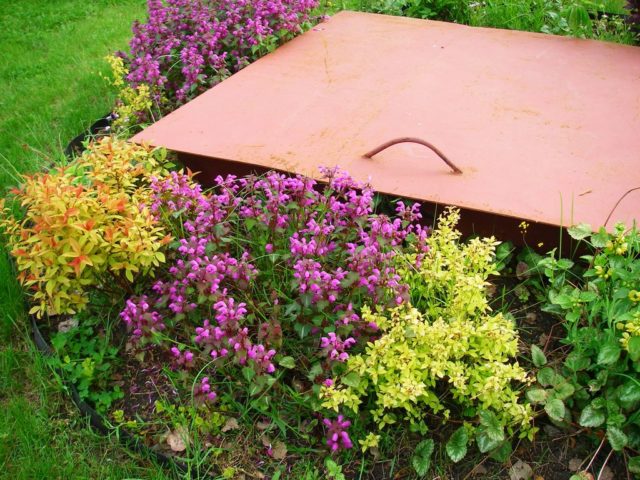
It is best to prepare raw materials in the morning
The collected dried purpurea flowers should be kept in tightly closed containers or vacuum packaging. Since they have a pleasant honey aroma and taste, various insects often live in them. The harvested raw materials can be used for the preparation of medicines for 24 months from the date of collection.
Conclusion
Purple lily is a plant that, in addition to its decorative qualities, has beneficial properties. The biologically active substances in its composition systemically affect the body and have a positive effect on the functioning of almost all organs. Claryweed is often used by herbalists in the treatment of many chronic diseases.
